RBSE Solutions for Class 10 Maths Chapter 13 Surface Areas and Volumes Ex 13.3
Rajasthan Board RBSE Solutions for Class 10 Maths Chapter 13 Surface Areas and Volumes Ex 13.3 Textbook Exercise Questions and Answers.
RBSE Class 10 Maths Solutions Chapter 13 Surface Areas and Volumes Ex 13.3
Take π = \(\frac {22}{7}\), unless stated otherwise.
Question 1.
A metallic sphere of radius 4.2 cm is melted and recast into the shape of a cylinder of radius 6 cm. Find the height of the cylinder.
Solution:
According to the question,
Radius of the sphere (r) = 4.2 cm
Radius of cylinder (R) = 6 cm
Let, Height of the cylinder = H cm
On recast, the volume remains the same as before i.e. here
The volume of sphere = Volume of cylinder

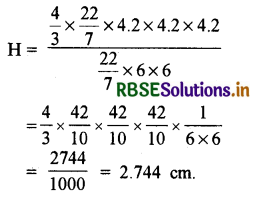
∴ Height of cylinder (H) = 2.74 cm
Question 2.
Metallic spheres of radii 6 cm, 8 cm, and 10 cm, respectively, are melted to form a single solid sphere. Find the radius of the resulting sphere.
Solution:
Radius of first sphere (r1) = 6 cm
Radius of second sphere (r2) = 8 cm
Radius of third sphere (r3) = 10 cm
Let the radius of the resulting sphere = R cm
The volume of three spheres = Volume of the larger sphere
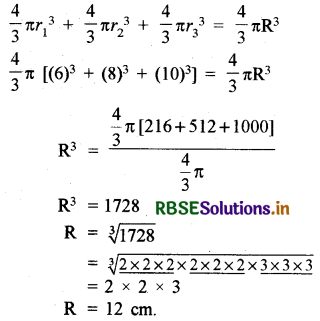
So, the radius of the larger sphere = 12 cm

Question 3.
A 20 m deep well with a diameter of 7 m is dug and the earth from digging is evenly spread out to form a platform 22 m by 14 m. Find the height of the platform.
Solution:
According to the question,
Diameter of well = 7 m
Radius of well (cylinder) = \(\frac{7}{2}\) m
Height of well H1 = 20 m
Length of platform (L) = 22 m
Breadth of platform (B) = 14 m
Let the height of the platform = H2 m
The volume of earth dug out from the well = Volume of the platform formed
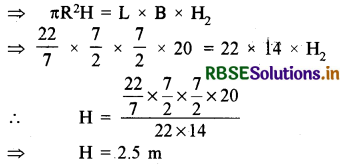
∴ Height of the platform (H2) = 2.5 m
Question 4.
A well of diameter 3 m is dug 14 m deep. The earth taken out of it has been spread evenly all around it in the shape of a circular ring of width 4 m to form an embankment. Find the height of the embankment.
Solution:
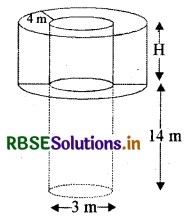
Depth of well (h) = 14 m
Radius of well (r) = \(\frac{3}{2}\) m
The embankment is of the shape of a hollow cylinder whose internal radius is equal to the radius of the well and the width of the embankment is 4 m.
Internal radius of the embankment = Radius of well (r) = \(\frac{3}{2}\) m
External radius of the embankment (R) = \(\left(\frac{3}{2}+4\right)\) m
= \(\frac{11}{2}\) m
= 5.5 m
Volume of earth taken out = Volume of embankment thus formed
⇒ πr2h = Volume of outer cylinder - Volume of inner cylinder
⇒ πr2h = πR2H - πr2H = πH[R2 - r2]
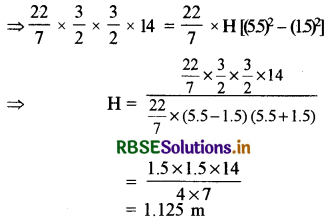
Hence the height of the embankment = 1.125 m
Question 5.
A container of the shape of a right circular cylinder of diameter 12 cm and height of 15 cm is full of ice cream. This ice cream is to be filled in cones of a height of 12 cm and a diameter of 6 cm, where the upper end is hemispherical. Find the number of these cones which can be filled with this ice cream.
Solution:
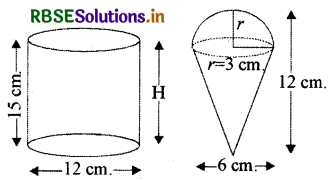
According to the question,
Diameter of cylinder (D) = 12 cm
Radius of cylinder (R) = 6 cm
Height of cylinder (H) = 15 cm
Diameter of cone = 6 cm
Radius of cone (r) = 3 cm
Radius of hemisphere (r) = 3 cm
Height of cone (h) = 12 cm
Let the number of cones used for filling the ice cream = n
Volume of ice cream in the vessel = n [Volume of ice cream in one cone]
⇒ πR2H = n [Volume of cone + Volume of hemisphere]
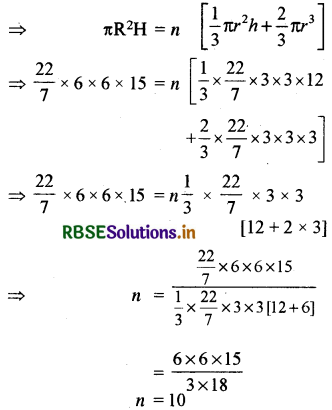
Number of cones formed = 10

Question 6.
How many silver coins, 1.75 cm in diameter and of thickness 2 mm, must be melted to form a cuboid of dimensions 5.5 cm × 10 cm × 3.5 cm.
Solution:
According to the question,
The silver coin is of the shape of a cylinder
Diameter of silver coin = 1.75 cm
∴ Radius of silver coin (r) = \(\frac{1.75}{2}\) cm
The thickness of silver coin = Height of cylinder (H) = 2 mm
i.e., h = \(\frac{2}{10}\) cm
Length of cuboid (L) = 5.5 cm
Breadth of cuboid (B) = 10 cm
Height of cuboid (H) = 3.5 cm

Let n silver coins be melted to form a new cuboid.
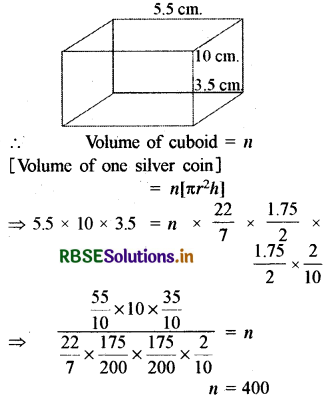
Number of coins melted = 400
Question 7.
A cylindrical bucket, 32 cm high and with a radius of the base of 18 cm, is filled with sand. This bucket is emptied into the ground and a conical heap of sand is formed. If the height of the conical heap is 24 cm, find the radius and slant height of the heap.
Solution:
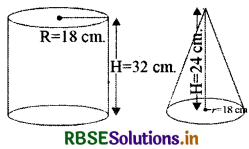
According to the question,
The radius of the cylindrical bucket (R) = 18 cm
Height of the cylindrical bucket (H) = 32 cm
Height of cone (h) = 24 cm
Let the radius and slant height of the cone be 'r' cm. and 'l' cm respectively.
Volume of sand in the bucket = Volume of sand in the cone
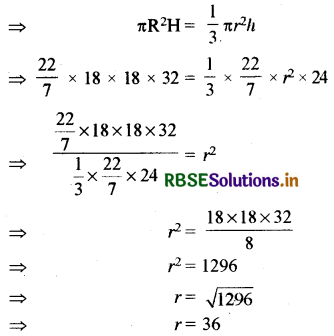
∴ Radius of cone (r) = 36 cm
We know that
(Slant height)2 = (radius)2 + (height)2
⇒ l2 = r2 + h2
⇒ l = \(\sqrt{(36)^{2}+(24)^{2}}\)
⇒ l = \(\sqrt{1296+576}\)
⇒ l = \(\sqrt{1872}\)
⇒ l = \(\sqrt{12 \times 12 \times 13}\)
⇒ l = 12√13 cm

Question 8.
Water in a canal, 6 m wide and 1.5 m deep, is flowing at a speed of 10 km/h. How much area will it irrigate in 30 minutes, if 8 cm of standing water is needed?
Solution:
According to the question,
Breadth of canal = 6 m
Depth of water in canal = 1.5 m
Speed of water = 10 km/hr
Water coming out in one hour = Speed of water that comes out in one hour
= (6 × 1.5 m2) × 10 km
= 6 × 1.5 × 10 m2 × 1000 m
= 90000 m3
∴ The volume of water that canes out in \(\frac{1}{2}\) hour = \(\frac{1}{2}\) × 90000 = 45000 m3
Let the area irrigated = (x) m2
According to the question,
8 cm of standing water is needed in the field
∴ The volume of water that comes out in \(\frac{1}{2}\) hour = Volume of water in the field
⇒ 45000 m3 = (Area of field) × Height of water
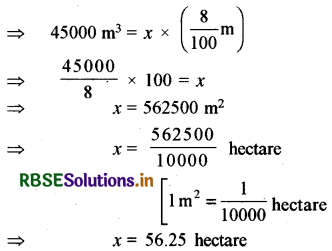
Hence the area of the field irrigated in 3 minutes by the canal = 56.25 hectares
Question 9.
A farmer connects a pipe with an internal diameter of 20 cm from a canal into a cylindrical tank in her field, which is 10 m in diameter and 2 m deep. If water flows through the pipe at the rate of 3 km/h, in how much time will the tank be filled?
Solution:
According to the question,
Speed of water = 3 km/hr.
Diameter of pipe = 20 cm
Radius of pipe (r) = 10 cm
= \(\frac{10}{100}\) m
= \(\frac{1}{10}\) m
Diameter of tank = 10 m
Radius of tank (R) = 5 m
Depth of tank (H) = 2 m
Let the pipe fill the tank in n minutes
Volume of water in tank = Water that flows through the pipe in n minutes
⇒ πR2H = n [Area of cross-section × Speed of water]
⇒ πR2H = n [(πr2) × 3 km/h]
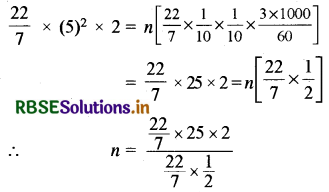
⇒ n = 25 × 2 × 2 = 100 minutes
∴ Time taken to fill the tank = 100 minutes
